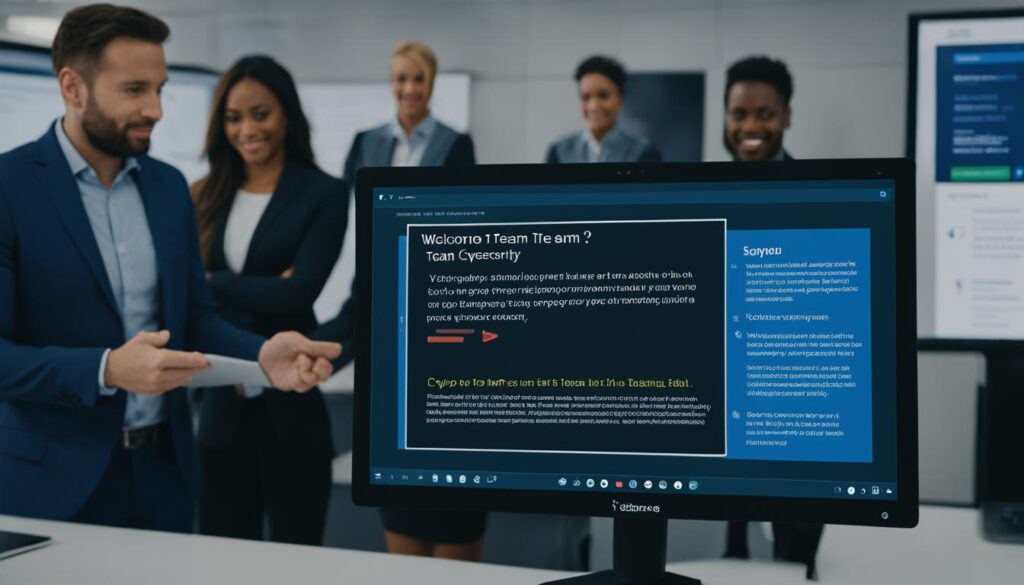Welcome to our step-by-step guide on how to effectively onboard retail employees! Building a strong onboarding program for your retail team is crucial for the success of your business. By following these simple steps, you can save time and money while ensuring that your employees feel confident and equipped to provide excellent customer service. So, let’s dive in and discover the key elements of a successful employee onboarding process in the world of retail.
Key Takeaways:
- Onboarding retail employees is essential for the success of your business.
- A comprehensive onboarding process includes welcoming new hires, completing necessary paperwork, introducing them to the team, and providing training on company policies and tasks.
- The goals of retail onboarding are to set expectations, establish good habits, promote company culture, and foster connections among team members.
- A strong onboarding program helps employees perform their jobs effectively and boosts customer satisfaction.
- Implementing digital platforms, ongoing support, and clear goal setting can overcome challenges in retail onboarding.
Why is Retail Onboarding Important?
Retail onboarding plays a crucial role in employee development and organizational success. By investing in effective employee onboarding best practices, you can ensure that your retail staff starts off on the right foot and thrives in their roles. This leads to increased job satisfaction, improved customer service, and decreased turnover rates.
One of the primary reasons why retail onboarding is important is that it sets clear expectations for employees. When new hires have a thorough understanding of their job responsibilities, they can perform their tasks effectively and avoid unnecessary mistakes or uncertainties. By clarifying job role expectations through the onboarding process, you can foster a sense of confidence and empower your employees to excel in their roles.
In addition to setting expectations, retail onboarding covers four essential topics known as the four C’s: compliance, clarification, culture, and connection. Firstly, compliance ensures that employees understand and adhere to legal regulations and company policies, promoting a safe and ethical work environment. Secondly, clarification allows new hires to fully grasp their job responsibilities, goals, and performance expectations. Thirdly, culture showcases the unique values, mission, and vision of the business, helping employees align with the overall organizational culture. Lastly, connection focuses on building relationships and networks within the team, fostering a sense of belonging and collaboration.
By implementing a comprehensive retail employee onboarding checklist, you can reap numerous benefits for your business. Decreased turnover rates are observed when employees feel supported, engaged, and confident in their roles. Increased job satisfaction arises from effective onboarding that instills a sense of purpose and provides the necessary tools for success. Improved customer service stems from employees who are equipped with the knowledge and skills to deliver exceptional experiences. Furthermore, an effective onboarding program directly contributes to increased revenue and minimized hiring costs, as it ensures that employees can contribute to the business’s bottom line more quickly and reduces the need for frequent recruitment and retraining.
To illustrate the importance of retail onboarding, consider the impact of an ineffective or nonexistent onboarding process. New employees may feel overwhelmed, uncertain of their responsibilities, and disconnected from the company culture. This can result in increased turnover, decreased productivity, and a negative impact on customer service quality. Don’t let your business suffer from the consequences of poor onboarding practices, take proactive steps to implement an effective retail employee onboarding program.

In the next section, we will discuss the challenges faced in retail onboarding and explore solutions to overcome them.
Challenges and Solutions in Retail Onboarding
Retail onboarding can present various challenges for businesses, including high employee turnover rates, dispersed workforces, and the need to onboard seasonal and part-time workers. However, by implementing effective solutions, these challenges can be overcome, leading to an improved onboarding experience for new hires and increased retention rates.
1. Digital Onboarding Platforms
One solution to address the challenges of retail onboarding is to utilize digital onboarding platforms. These platforms streamline the onboarding process by providing a centralized hub for new hires to complete necessary paperwork, access training materials, and familiarize themselves with company policies and procedures. Digital platforms not only save time and reduce paperwork but also ensure consistency and accuracy in the onboarding process.
2. Mobile Training Tools
In today’s mobile-centric world, providing on-the-go access to training materials is crucial. Retail businesses can leverage mobile training tools, such as mobile apps or responsive websites, to deliver bite-sized training modules that can be accessed anytime, anywhere. Mobile training tools allow new hires to learn at their own pace, making the onboarding process more flexible and convenient.

3. Regular Check-Ins and Feedback
Regular check-ins and feedback sessions during the onboarding period are crucial for new hires to feel supported and valued. These sessions provide an opportunity to address any concerns or questions, ensure the smooth integration of new hires into the team, and gather feedback to continually improve the onboarding process. Encouraging open communication and providing ongoing support can contribute to the success and satisfaction of new retail employees.
4. Ongoing Onboarding Beyond the First Month
Retail onboarding should not be limited to the first month only. To fully integrate new hires into the company culture and set them up for success, it is essential to continue the onboarding process beyond the initial training period. This can include ongoing training sessions, mentorship programs, and opportunities for skill development. By providing continuous support and growth opportunities, retail businesses can enhance employee engagement and retention.
5. Clear Goal Setting
Setting clear goals for new hires during the onboarding process helps to align their expectations and performance with the organization’s objectives. Clearly defined goals provide a sense of purpose and direction, allowing new employees to understand their role within the company. Regularly reviewing and adjusting goals throughout the onboarding period can help track progress and provide constructive feedback.
6. Buddy Systems
Implementing buddy systems, where new hires are paired with experienced employees, can facilitate knowledge transfer, foster relationships, and accelerate the integration process. Buddies serve as mentors, guiding new hires through their onboarding journey, answering questions, and offering support. This peer-to-peer connection can help new retail employees navigate challenges and feel more comfortable in their new role.
7. Easy Accessibility to Training Materials
Ensuring easy accessibility to training materials is crucial for the success of retail onboarding. Providing a user-friendly learning management system or a centralized online repository allows new hires to easily access and reference training materials, policies, and procedures. By making information readily available, retail businesses can empower new employees to quickly learn and apply their knowledge on the job.
By addressing the challenges of retail onboarding and implementing these solutions, businesses can create a more efficient and effective onboarding process. These strategies contribute to improved employee satisfaction, reduced turnover rates, and ultimately, better business outcomes.
How to Improve Retail Employee Onboarding
Improving retail employee onboarding is crucial for fostering a positive and productive work environment. By implementing effective practices, you can ensure that new hires have a smooth transition and become valuable assets to your team. Here are some best practices to enhance your retail employee onboarding:
1. Make the process mobile-friendly
Utilize digital platforms and provide training materials that can be accessed through personal devices. This allows employees to engage with the onboarding process conveniently, even when they are not physically present at the workplace.
2. Schedule regular check-ins and feedback
Continuously assess the progress of new hires by scheduling check-in meetings and providing constructive feedback. This helps address any concerns or questions they may have, ensuring their development and growth within the company.
3. Extend onboarding beyond the first day
Onboarding should not be limited to the first day alone. Extend the onboarding program to the first 120 days to provide ongoing support and guidance. This extended period allows new hires to gradually adapt to their roles, build confidence, and become fully productive.
4. Encompass organizational, technical, and social aspects
A comprehensive onboarding program should cover organizational, technical, and social aspects. Provide a clear understanding of the company’s structure, processes, and values. Ensure employees receive thorough training on essential tasks, technology platforms, and systems. Foster a sense of belonging by facilitating introductions to team members and promoting a positive work culture.
5. Utilize a lean onboarding tech stack
Streamline the onboarding process by integrating a lean onboarding tech stack. This includes using automation tools for paperwork, scheduling software for training sessions, and digital platforms for sharing important resources. Simplify administrative tasks to save time and optimize efficiency.
6. Tailor onboarding to seasonal hiring needs
In retail, hiring often fluctuates based on seasonal demands. Adapt your onboarding process to accommodate the unique requirements of seasonal hires. Provide concise training that emphasizes key tasks and goals, ensuring they quickly integrate into the team and contribute to the business’s success.
By implementing these best practices, you can enhance retail employee orientation and onboarding, resulting in engaged and capable employees who positively contribute to your business’s success.
Conclusion
Creating a successful retail employee onboarding program requires careful planning and consideration. By following the step-by-step guide outlined in this article, retail businesses can elevate their onboarding practices and set their employees up for success. From setting clear goals to delivering a great first impression on the first day, providing ongoing support and training, and utilizing onboarding technologies, retail businesses can improve employee retention, performance, customer service, and ultimately, their bottom line.
Effective onboarding practices play a crucial role in ensuring that new retail employees quickly become productive and engaged members of the team. By implementing a well-structured onboarding process, businesses can help new hires integrate seamlessly into their roles, understand company values and expectations, and establish strong connections with their colleagues.
Remember, the retail employee onboarding process doesn’t end on the first day. It’s an ongoing effort to support new hires as they navigate their roles and develop their skills. By consistently evaluating and refining your onboarding program, you can create a culture of continuous improvement that drives success and growth. By prioritizing effective onboarding practices, retail businesses can build a strong and engaged workforce, leading to increased productivity, customer satisfaction, and overall business success.
FAQ
What is retail onboarding?
Retail onboarding is the process of welcoming and training new hires in the retail industry. It involves completing necessary paperwork, introducing employees to the team, and providing training on essential tasks and company policies.
Why is retail onboarding important?
Retail onboarding is important because it sets expectations for employees and equips them with the knowledge and skills needed to perform their jobs effectively. It helps ensure consistency in customer service and promotes employee job satisfaction, improved customer service, and increased revenue.
What are the challenges in retail onboarding?
Challenges in retail onboarding include high employee turnover rates, dispersed workforces, and the need to onboard seasonal and part-time workers.
What are the solutions for overcoming retail onboarding challenges?
Solutions for overcoming retail onboarding challenges include utilizing digital platforms for onboarding, implementing mobile training tools, scheduling regular check-ins and feedback sessions, providing ongoing onboarding beyond the first month, establishing clear goal setting, implementing buddy systems, and ensuring easy accessibility to training materials.
How can retail employee onboarding be improved?
Retail employee onboarding can be improved by making the process mobile-friendly, utilizing digital platforms, providing regular check-ins and feedback, extending onboarding beyond the first month, encompassing organizational, technical, and social aspects, utilizing a lean onboarding tech stack, and considering seasonal hiring needs.




